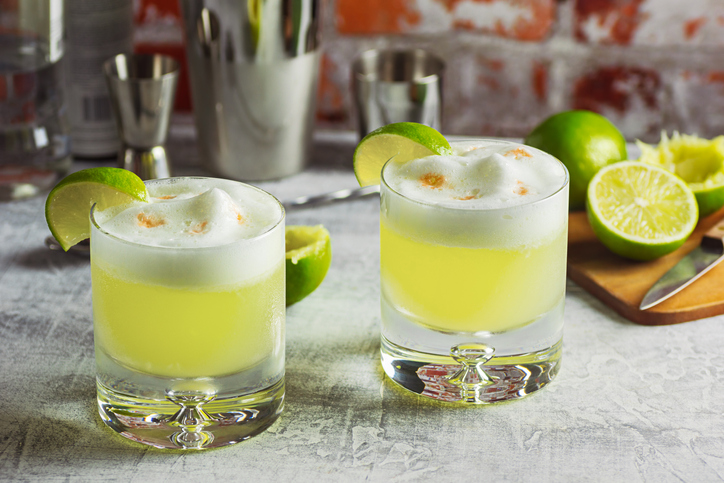Besides the Pisco Sour and the Chilcano, the Peruvian distilled spirit par excellence is a hugely versatile liqueur, used in a wide array of cocktails that can be made at home by the most daring readers.
Pisco, with over 400 years of history, is the Peruvian distilled spirit par excellence. Produced exclusively in the lower half of the country, in the strip between Lima and Tacna—Peru’s southernmost city—this spirit is increasingly common in cocktail bars all around the world.
This is due to its huge versatility: being a fruit-based distilled spirit (rather than grain-based), the flavours and sensations offered by pisco naturally go better with other drinks, making it a highly appreciated spirit amongst bartenders.
In 2018, the value of imported pisco in Spain rose to €584,654 FOB (free on board), making it the second largest purchaser from Peru behind only the USA. This figure dwarfs the figure of €110,594 in 2014, highlighting this distilled spirit’s growing popularity in this country. Despite this high figure, Spain’s pisco importation record of the last 5 years occurred in 2017, with €654,249 FOB spent on importing this product.
Pisco is now, therefore, becoming one of Spain’s most popular spirits amongst those of a more sophisticated pallet. With a distinct identity and flavour, this distilled spirit is produced through the fermentation of grapes. Their are eight different grapes, which means there are eight main types of pisco: some varieties are made from non-aromatic grapes (Quebranta, Negra Criolla, Mollar and Uvina), whereas others are made from aromatic grapes (Italia, Moscatel, Torontel and Albilla). This variety reflects the diversity of Peru’s climates and ecosystems, encapsulated in its most famous drink as well as its cuisine.
Fermentation: key when defining the purity
This distilled spirit’s infinite number of combinations have led to discussions about “pure” piscos and mosto verde piscos. These two types have very different methods of production, leading to completely different flavours. There are “pure” piscos, made from any of the eight types of grape, and mosto verde piscos, which follow a production process in which the grapes are not entirely fermented, giving the spirit a more intense flavour.
Pisco’s various flavours and great versatility have led to it finding its own space in modern cocktail making, being used in a range of combinations that open up a whole world of possibilities, but which are also able to satisfy many different pallets—even the most sophisticated ones:
Pisco Sour
Lemon juice, sugar, egg white and ice. You will need these ingredients to make the most popular pisco-based long drink: the Pisco Sour. This cocktail was first made practically 100 years ago in Morris Bar, owned by American barman Victor Morris. Since then, the formula spread to various hotel and restaurant bars, where it was enjoyed by celebrities such as John Wayne and Walt Disney.
Such is this cocktail’s popularity in Peru that they even celebrate the “Día del Pisco Sour” on the first Saturday in May, paying homage to this product that helps to strengthen the ‘Peru brand’ on a daily basis.
Chilcano
The Chilcano is a “pure” pisco-based cocktail, to which lemon juice, angostura bitters, ginger ale and sugar are added. For Peruvians, Chilcanos are a popular cocktail that are often enjoyed during meal times. It is also considered to have great restorative properties, hence the name “Chilcano”, which is also used to refer to a fish stock from the northern coast of Peru.
This Peruvian drink first became popular in immigrant bars and bodegas, such as the Santiago Queirolo, the Cordano, the Carbon and the Arboccó. It’s popularity later soared, becoming a staple on the menus of the country’s most exclusive restaurants.
El Capitán
This is a classic cocktail in Peruvian culture, first created in the 1920s. It’s well-known for containing red vermouth, pisco, cherry and ice. We recommend chilling the glass first, as this will ensure that the drink will be enjoyed at the correct temperature.
The drink’s name of “El Capitán” derives from the fact that it was initially consumed by captains who were finishing their rounds, helping them to battle the cold weather in the Sierra de Puno, the birthplace of this cocktail. Years later, it would cross the Peruvian mountains and reach the capital city of Lima.

Pisco Point
This is one of the sweetest and freshest cocktails made from this grape spirit, which can hold its own against the most daring new drinks in the world of cocktail making. This cocktail is made from pisco, apple liquor, star anise (a spice that tastes very similar to anise) and a Sicilian bitter (a herb-based digestif).
Pisco Tonic
As its name might suggest, this cocktail combines pisco and tonic water, with the bubbles lending it a sweet and fresh taste. This is the perfect long drink if you’re looking to try this grape liqueur—a great option for G&T lovers!
Andes Amables
This cocktail, which mixes pisco with vodka, has a strong and lingering aftertaste. The edge is taken off slightly through the addition of ice and lemon juice, which gives it a refreshing note.
Peruvian Flip
This cocktail goes brilliantly with desserts, as it contains sweet ingredients that give it a distinctive and highly characteristic flavour. It is commonly served alongside a small amount of chocolate and fruit, making it the perfect post-meal or mid-afternoon drink. It contains pisco, dairy cream, coffee cream, one egg white and three ice cubes.

Aguaymanto
The exotic flavour of the Peruvian groundcherry superfood shines through in this cocktail; besides being delicious, it is also high in protein, phosphorus and vitamins A, B and C. The cocktail also includes sugar, coconut cream and ice. The combination of these ingredients lends a sweet and refreshing fruity flavour to the drink.







